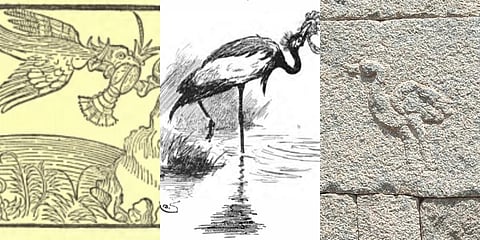

IN PIC ABOVE: (L) A woodcut illustration (c.1570) from a Latin translation of ‘The Crane Killed by the Crab’; an illustration by Gordon Browne for the story of ‘The Crane and the Crab’; the carving of a crane on the outer wall of Sri Bala Krishna Temple in Hampi (c. 1515)
Sarasa and baka, which in Sanskrit mean the crane, figure prominently in ancient Indian literature and art. In the Yajurveda Samhitas, “balaakaa” (crane) was mentioned as an offering made in the Asvamedha (horse sacrifice). In the Mahabharata, the sweet humming sarasas were mentioned as dwellers in the Himalayas and in the lakes and rivers surrounding the Gandhamadana mountain. The Ramayana narrates an episode in which Valmiki sees a pair of krauncha birds, which are identified by scholars with the sarasa, and a hunter shooting down the male one. The resulting soka (sorrow) made Valmiki first compose a sloka (verse) in Sanskrit and then the epic, as a form of catharsis from the resulting sorrow.
In ancient Indian fables, however, the crane figures as a vicious bird that stays still in water, only to catch fish as prey. Idioms such as “baka-dhyanam” in Sanskrit and “konga-japamu” in Telugu, meaning the meditation of a crane, were used to denote a hypocritical person with ulterior motives. Another Sanskrit idiom, “Bakaha-parama-dharmikaha” (the crane is very virtuous), indicates the irony of outward decency and the pretence of virtue, but inwardly aiming at injury to others. Apparently, after reaching the Pampa Lake, Rama is known to have said, “Behold Lakshmana, for fear of destroying life, it places its feet in the Pampa lake, the crane is very virtuous!” In the Bhagavata, the demon Baka comes in the form of a mighty crane and Krishna kills it by ripping apart its bill. This episode has been profusely illustrated in many schools of painting and sculpture across India.
The Panchatantra in Sanskrit narrates a well-known story of the crane killed by the crab, which was also retold with minor changes in the Hitopadesa in Sanskrit, the Buddhist Baka-Jataka in Pali, and in various anthologies in many languages, including a Latin version with woodcut illustrations (c.1570). Sir Edwin Arnold translated the story in The Book of Good Counsels, and Gordon Browne drew an illustration for it. The Mughal painter, Ustad Mansur, under the patronage of Jahangir, did a series of paintings of a variety of fauna that appear like ‘true-to-life’ studies, and two such works show a Siberian crane and a pair of the Indian sarasa cranes.
In such a backdrop, a unique carving of the crane, hewn out of a granite block on the outer wall of Sri Bala Krishna Temple that was built by Sri Krishna Deva Raya in 1515 at Hampi, has been perplexing me ever since I noticed and photographed it more than a decade ago. Strange as it may seem, an anonymous artist had carved the crane on a single slab of the wall of great height and width, with no other figure around it. The crane was presented here like a ‘true-to-life’ study, with no association with any epic story or fable; it appears to be a subtle rendering of the crane that could be categorised as a nearly finished or partly unfinished sketch rather than a detailed study. By carving out with a few chisel strokes, the artist made discernible every natural aspect of the aquatic creature. The seemingly unfinished quality of the carving that presents the wholeness of the bird, in my opinion, makes the work very intriguing. Incidentally, Sri Krishna Deva Raya had written a few verses on the behaviour of the cranes in a pond in the summer in his long poem in Telugu, Amuktamalyada, which I had translated and published in 2010. The verses, in a fresh rendering done by me, go as follows:
A crane, which got sores in its throat for having dry moss, / Stood absolutely still in the pond as the breeze suggested / The presence of fish in the surroundings; / Another crane walked in the muddy pond / From one end to the other / While gulping ulucha fish and snails; / Another crane shook its leg / When a crab had caught hold of it / And bit the creature with its beak; / Another crane walked through / The chema leaf-like lotus leaves / And took shelter amid the jeelugu bushes; / Behaving thus in the muddy pond / The cranes appeared to have made the pond waterless… / At first, flocks of big cranes / Had gulped big fish in the muddy ponds; / Later, as the mud became dry and cracks appeared / They grabbed the bommidaayalu that were hiding beneath the lotus roots / Then on, they poked their beaks in-between the cracks of mud in the pond / And ate the dead bommidaayalu and thorn fish.
Interestingly, the unknown artist of the crane on the wall of the Sri Bala Krishna Temple had presented his version of the ‘true-to-life’ nature of the crane through visual language and the emperor-poet who built the temple had also narrated the true behaviour of the same bird, but of course, in greater detail. Indeed, both the visual presentation and the textual description stand out as great examples for the portrayal of naturalism and the keen observation of the natural behaviour of the crane.
Srinivas Sistla
Associate Professor, Department of Fine Arts, Andhra University, Visakhapatnam
(sistlasrini@gmail.com)